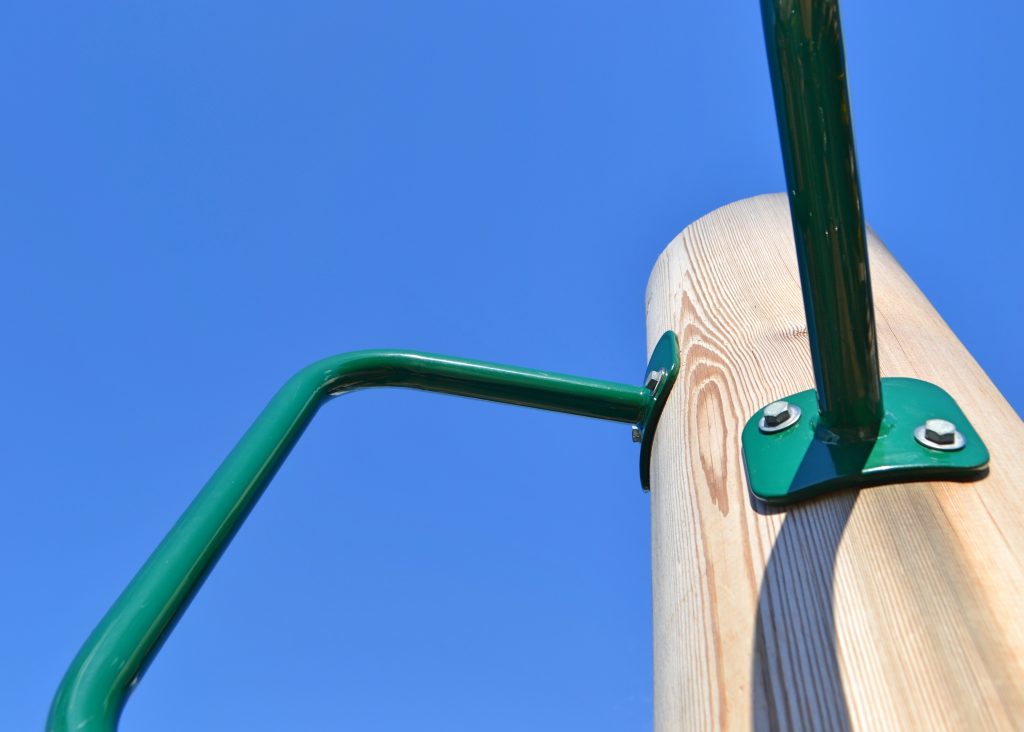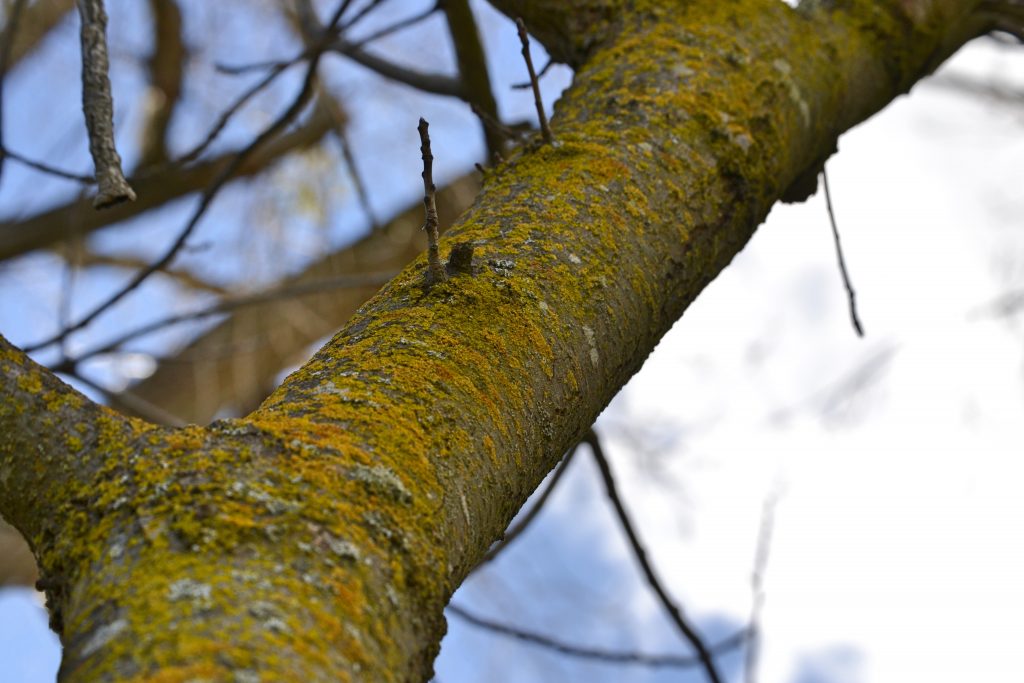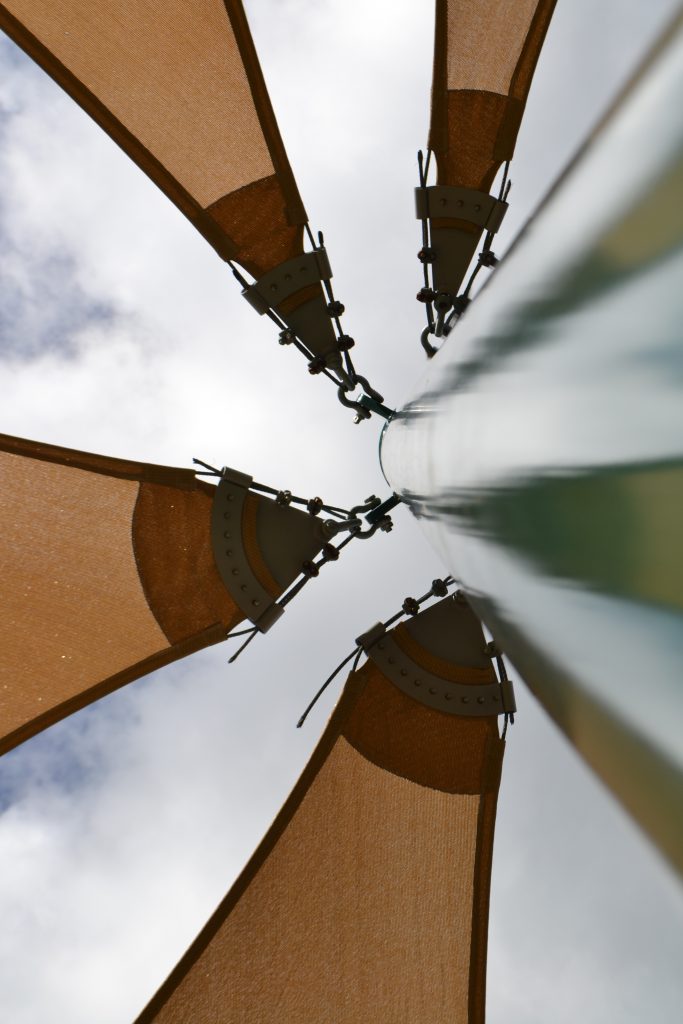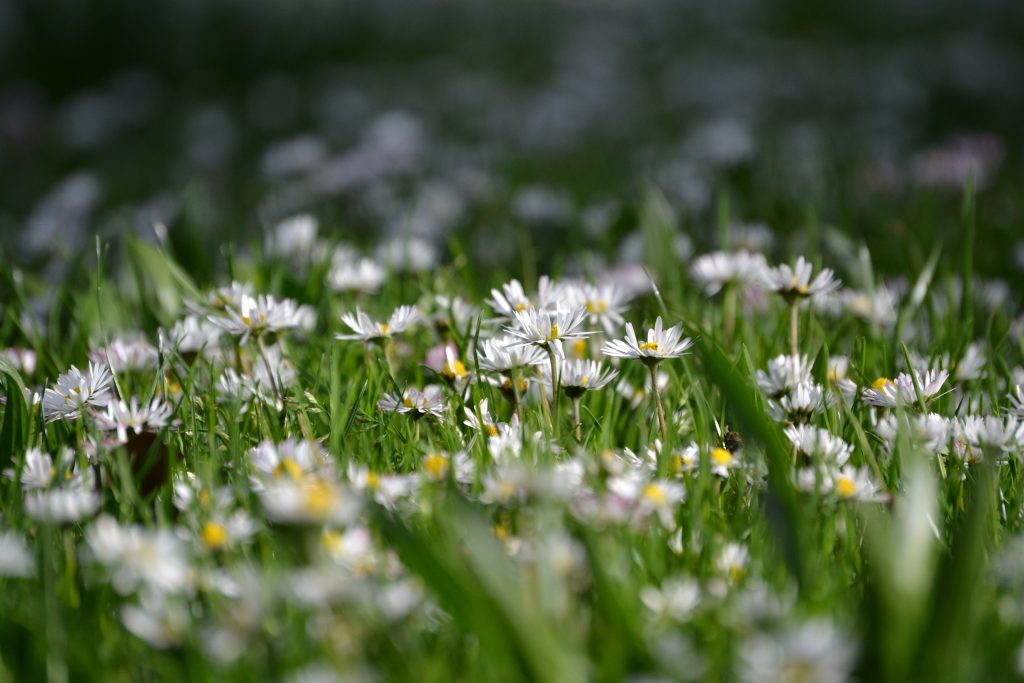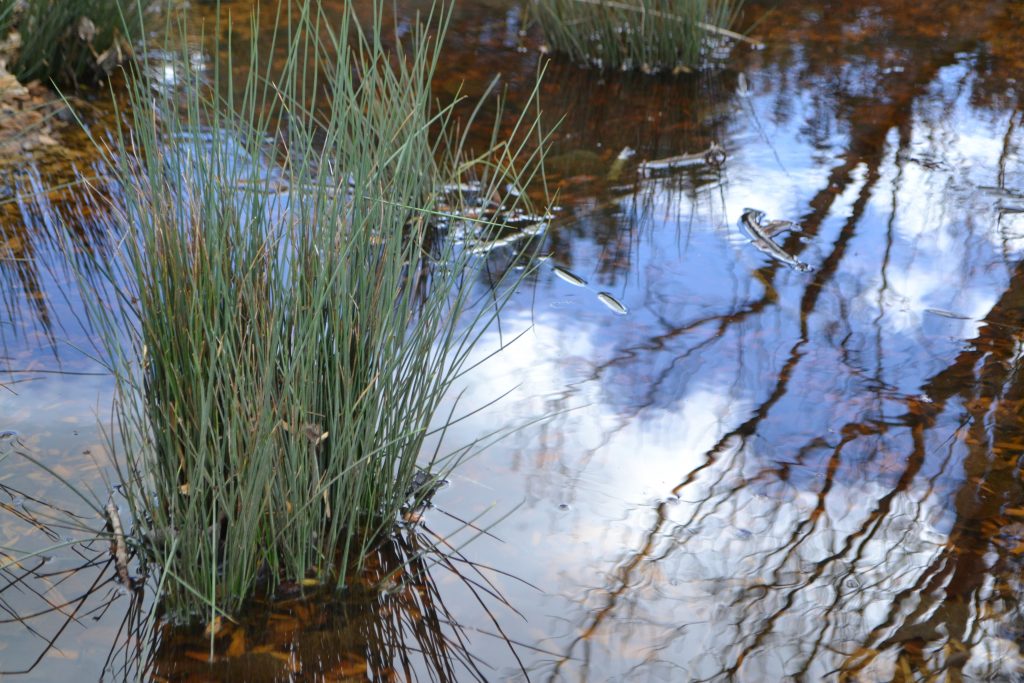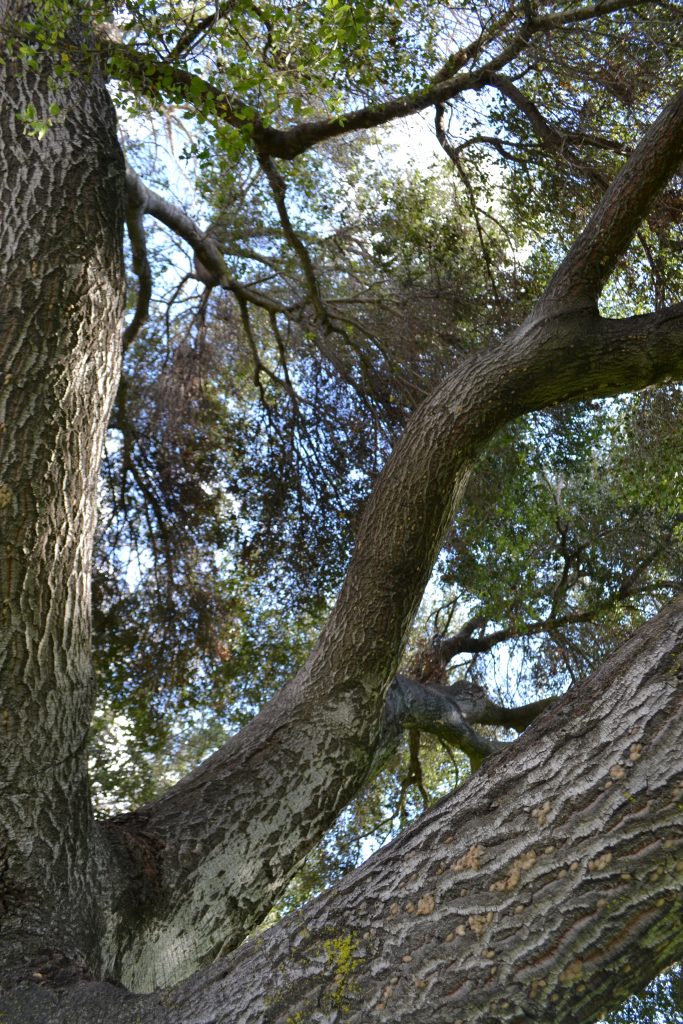


Traveling around in #SanJose and #NearbyToSanJose at 825 mph on our spinning planet.


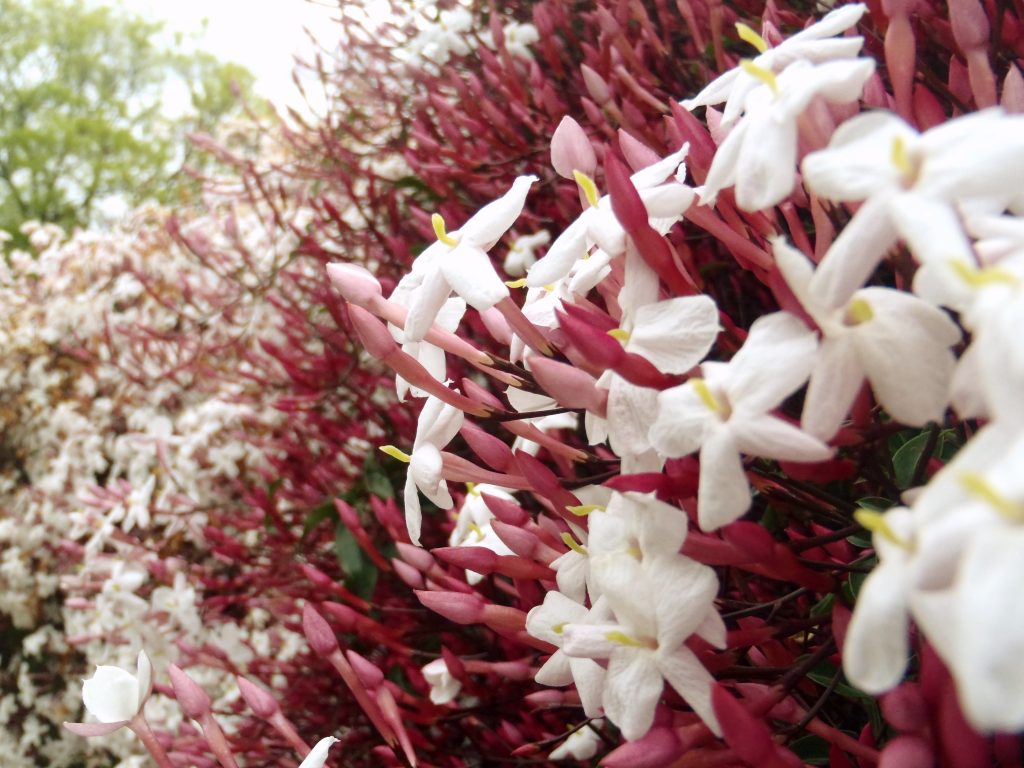


It is such a great time to go for walks and to smell the world.

Do you remember when old cars use to have metal bumpers? Well, bumpers use to be chrome and I think the move to plastic painted bumpers, while aesthetically pleasing, accounts for the comparably low turnout of colorful bumper stickers on the road these days. My hypothesis is that humans love color and can’t help but try to fill it in where they can. And a plain chrome bumper is practically begging for a splash of color. When I was growing up in San Jose, one of the bumper stickers I would notice often was the bright yellow “The Mystery Spot” bumper sticker. I still see them from time to time, some brave souls sticking them to their painted bumpers and some crafty drivers affixing them like band-aids to their bumper’s scratches. More often these days, bumper stickers of all colors find themselves on the chrome like covers of laptops.. Laptops- the chrome bumpers of today, begging for a splash of color. Just realized that, hmm.
Well, despite seeing all those stickers for years and talking to friends who had been there, I had never, until a few days ago, actually gone to The Mystery Spot in Santa Cruz.
I am sooo glad that I finally went!
Okay, in simplest form, what you are overtly going to see at The Mystery Spot is a single small wooden building on a hill. I was made to understood from friends over the years that the deal with this place is supposed to be about some crazy energy vortex causing water to flow uphill and other weird things. And, of course, I knew it was some kind of trick optical illusion. But it was so much more than that. It would have to be for this pace to be an actual California Historical Landmark, Landmark #1055.
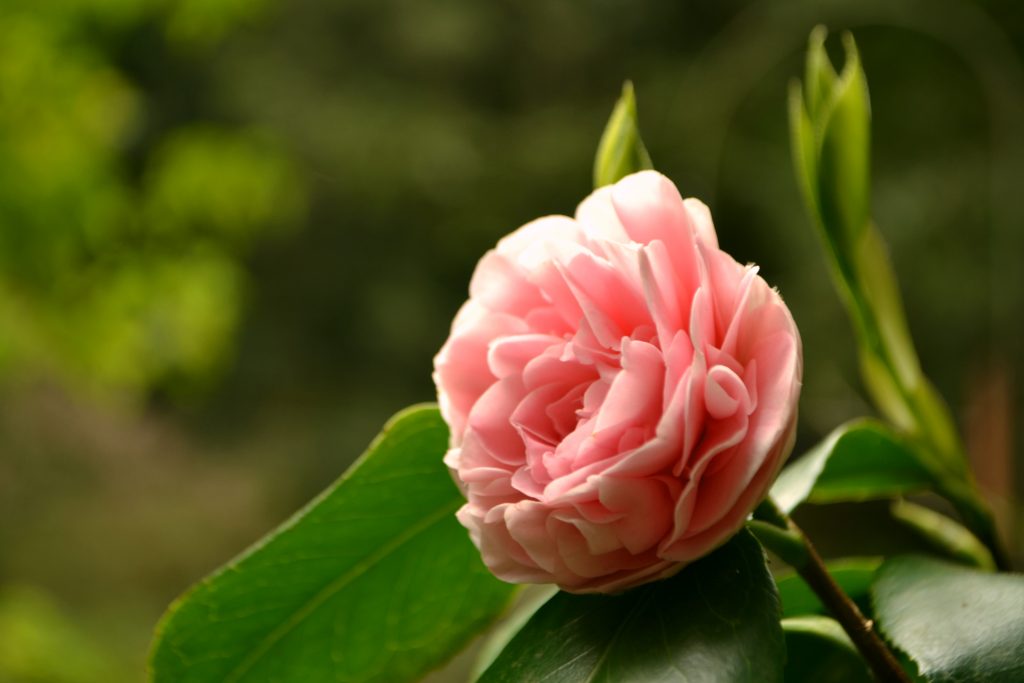
First impression upon arriving? Wow, these are friendly people. Really. The guy in the parking lot was the happiest and friendliest parking lot guide I could imagine, magnified by approximately 300%. As if I ever imagined there was such a job as a parking lot guide welcoming me as I drove passed and pointing out an open spot in the free parking lot with a smile. Then, as we walked into the place, we were greeted by… well, a greeter, with three badges declaring “Greeter” on his shirt and the friendliest of demeanors. Another guy sweeping up paused to chat and make me laugh and talk to my kids. What kind of happy-crazy-town is this?
Second impression? It only costs $8 to go in! What? I can not believe that a destination type place near us could only cost $8 to get into in the year 2019. Yes, I am about to see a small sideways wooden building and so charging $8 is theoretically about right when you consider restrooms, etc. provided out in the forest…but I assumed that nothing with such name recognition would have a reasonable cost. Shocked, is what I was! I mean, it costs $6 to park in most of our County Parks and they don’t have greeters walking around to make you smile. I’m not complaining, I love our County Parks and happily buy my annual parking pass every year. It’s just that I was impressed and surprised that any destination type visit could have a cost that has become less than most people would spend for a fast food meal.
Eventually, it was our turn for the tour. How would they do it, I wondered. Serious, perhaps, and explain the warp zone vortex what-cha-ma-call-it like a crazy cult follower? Or with a surly attitude, like a minimum-wage-paid teen in need of the money who knows they are supposed to sell some wacky story to a bunch of adults who should know better? Critically, maybe, like a scientist who drank the kool-aid? Well, it was none of the above. I should have known better after seeing so many friendly employees and the fact that this place has been around since decades before I was born.
The tour guide was young but there was no hint of a surly attitude or kool-aid induced craziness. No, he was simply funny! It turned out to be a performance after all and one that was welcomed and entertaining. How long did it take this place to perfect this art? The whole presentation was perfect. Perfectly funny with silly jokes, perfectly presented with quasi-possible story telling, and still perfectly sane in its silly delivery. I was again impressed.
And then, while I continued to just enjoy the show and wondered at the optical illusions before me, it was our turn to spend some time in the cabin. And that is when I experienced the best $8 worth of awesome I could have imagined. I became giddy like a child inside. How in the world could an illusion create so real a visceral response in me? It was AMAZING! I was consciously walking in an optical illusion and happily continued to to have my senses and rational mind boggled by the experience in a tug-of-war of sensory befuddlement and mental tennis. Even when I utilized all of my wits to see the reality as I was in it, it would only take seconds without my full attention before my mind was tricked again into feeling and behaving as though I were in a warped world. This caused me to alternate between wanting to fall over, wanting to sit in a dizzy spell, sometimes feeling my stomach twist in a dangerously vomit threatening way, and wanting to laugh with joy. All of this was internally. Externally, I was just trying to hold my self together as I walked in that building. It was the silliest and coolest thing I have done in a long time. It was like the thrill of a new toy as a child mixed with the bafflement of a great card trick done before your eyes mixed with the fun of being at a cool dress up party while spinning on an amusement ride. Am I over selling this experience? I don’t think so. If you go to The Mystery Spot and aren’t physically effected by the leaning shack then I am certain scientists will be able to study you for some kind of rare genetic mutation affecting equilibrium. And if you don’t happily let your guard down to enjoy the tour while being charmed by the friendly shtick of the tour guide, than I don’t know what could please you. And if all of that does not sound amazing for the price of one fancy coffee drink, than I don’t know how to impress you.
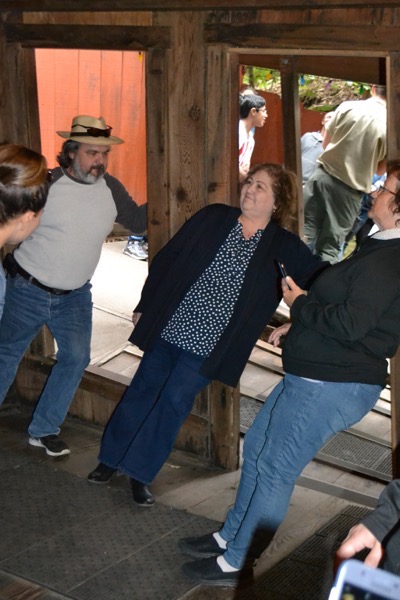
I realized the fun of this place was neither about being duped nor figuring it all out, because what you were able to understand did not matter. For me, it was the fun of being amazed at how my body dealt with the optical and physical illusion.
My final assessment of The Mystery Spot? It is a seemingly magical giddy-inducing-silly-amuzement-ride-lke-experience created from subtle performance and illusions so good you will happily throw your mind into it to be boggled, all for the price of a fancy coffee drink.
It was simply wonderful to feel this childish fun.

From the northern tip of San Jose, or nearly anywhere with a view of the south San Francisco Bay, you can look to the south east shore that is Newark and see a white mound. That white mound, if you go to Newark for a visit, is a giant mountain of salt!

Notice the telephone poles on the left of the above photo. Or the railroad cars on the right. That is a big mountain of salt. It gets bigger or smaller as the harvesting cycles through. It is the only solar evaporative salt production facility in the U.S., producing 500,000 tons of sea salt each year!
The history of salt collection on the San Francisco Bay goes back hundreds of years with the Ohlone Native Americans collecting salt along the bay shore. Commercial production began in 1854 during the gold rush. Water is pumped or flows from one evaporation pond in the bay to the next, taking 3 to 5 years (depending on the source read) and traveling miles through the pond network before the water has evaporated enough; concentrating the salt in the final pond for harvesting, cleaning, and packaging on the shore of Newark.
It’s amazing to see so much salt! My kids are as surprised as I that a product acquired by evaporating water out is then washed in water as part of the cleaning process without washing it all away. It’s interesting to imagine the long journey these salt molecules make out there, suspended in ocean and bay water for countless years, bonding and crystalizing with their neighbors, being piled up so high, cleaned and packaged for anyone to buy at a local grocery store. Salt is so much more interesting to taste when you imagine where its been all these years.
Today, much of the former salt pond area of the bay is part of a marshland restoration project to bring back the natural habitats while keeping a smaller area for salt harvesting. Modern efficiency has increased production with a smaller footprint. We are still in the early years so it will be interesting to see the continued changes along the bay in the years to come.
Below is a photo from northern San Jose in Alviso where you can see the giant salt mountain in the center across the bay.
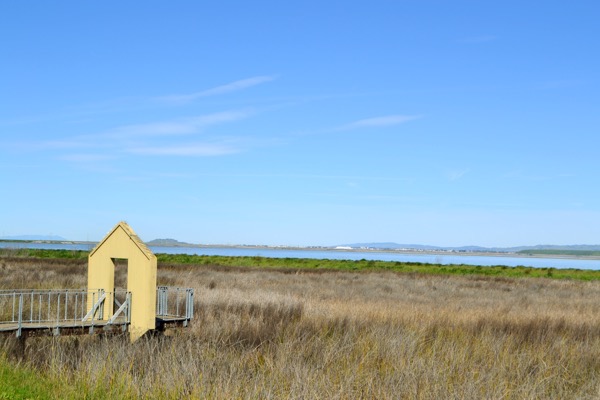




The river begins on the north side of Lake Almaden, where the Alamitos Creek merges with the Guadalupe Creek to become the Guadalupe River. This is all happening right next to the Almaden Light Rail Station.
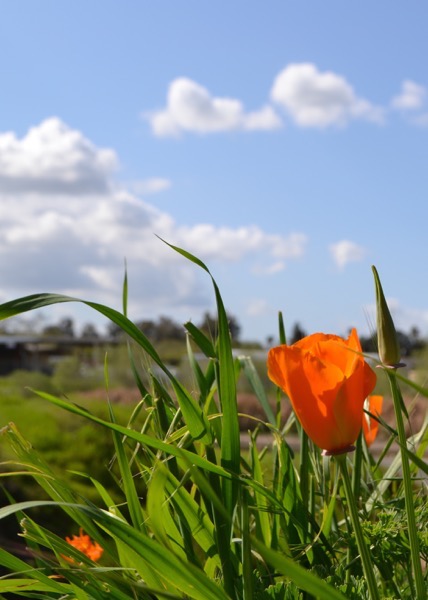
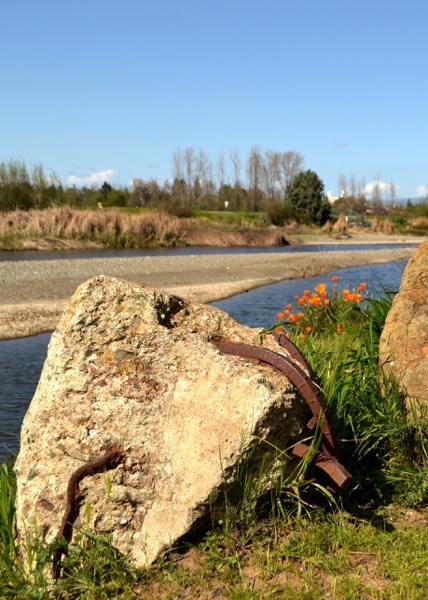



Lick Observatory, that white bump visible to the east of us in San Jose, sits atop the highest mountain top in our area, Mt Hamilton. The observatory is an orienting landmark, an important scientific observatory, a monument in history, and a great place to visit.

I am drawn to this place. It seems so distant, high on that mountain, but then only takes about an hour to get to. And from another perspective, it seems incredible that we can see anything from San Jose that takes an hour to drive to. The path to get there is 25 twisty miles by road and 4,209 ft above sea level (a little more than the Yosemite Valley), compared to San Jose’s 49 feet above sea level. Granted, San Jose has an altitude range from -13 feet to 2,125 feet. The road, depending on the source, has 360 or 365 turns on the way to the top. I have never counted the turns, myself.
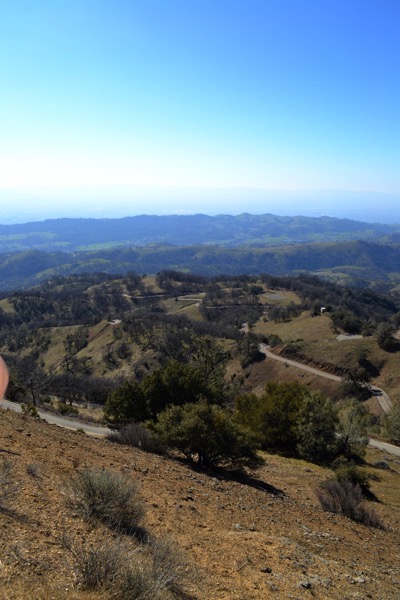
Scientifically, this is a significant research facility as part of the University of California. With at least nine telescopes in operation, Lick Observatory has become the premier facility in discovering new planets. In fact, it confirmed the first extrasolar planet in 1995. The 36 inch refracting telescope, its first and one that you can still visit today, was the largest in the world when constructed in 1888. Short tours are given of the telescope during open business hours. I go on this tour every time I visit which means I have been on this tour approximately 20 times. It never gets old and each time the presenter gives the presentation differently, with different degrees of history and different points of fact. A visit, to me, is an exercise in anticipation of the view, then greeting the 130 year old telescope, and then listening to how the presentation will go differently from all the times I have heard it before. It’s not a bad ritual. Some presentations are far richer and I treasure those like a delicious desert. On two, just two, occasions the presenter raised the elevating floor of the telescope room and let us peer at the grave stone for James Lick, buried beneath the giant telescope. With 130 year old gearing, it is understandable why they nearly never raise the floor during the multiple presentations given most days of the week. And so, I remember those two times as quite special. Some presenters like to share lots about the history, some share a soap opera like account of the life of James Lick, and others know a few facts about the telescope. No mater what, it is wonderful to stare at this 130 year old beautiful art-meets-science technology. Good stuff for the imagination and spirit. There are other telescopes to see as well, a gift shop, and several great spots to have a picnic lunch. And the views! Worth seeing many times over and in different weather conditions. The road is a bit scary, winding, narrow, and precarious feeling at times. Getting past that by focusing all of my attention on the road while driving and saving sight seeing for safe stopping points is the only was I manage to make the trip so often. Don’t forget to drive carefully for you own safety by ignoring the views until you stop, but also to be aware and cautious of the many bicycle riders who make this journey each day. I don’t know how humans can do this on a bicycle and it is amazing that so many do this so casually as if they don’t each deserve a standing ovation after the completion of such a challenge.

As a bit of history, Lick Observatory certainly has its place, especially in connection to James Lick who paid for its construction. James Lick has the kind of life primed for a good story teller. A few examples of facts a good story teller would get to weave in include: leaving the country to make his fortune; actually making that fortune; multiple journeys across nations; a child born during a youthful romance; bringing chocolate to the US to sell and then writing his friend, Ghirardelli, of the successful sale and urging him to locate in California to sell more, yes- that Ghirardelli; building the largest mill on the west coast; building the largest telescope in the world; funding numerous public projects in the San Jose and San Francisco area; becoming the richest person in California, owning most of the area around Lake Tahoe, all of Catalina Island, and lots of property in the San Jose area; as well as being buried under one of the neatest monuments ever used as part of a head stone, the giant 36 inch refracting telescope. That’s a lot to work with and that’s not even everything.

It is amazing to think about the innovation, science, and development that has occurred in our area over the years. So much of that is due to decisions that created opportunities for people to share ideas with one another, to spark new ideas, and provide space for their development. So much of this special opportunity comes from people making decisions like James Lick building the worlds largest telescope in his world. That decision has kept thinkers in our area and brought visiting thinkers to our parts. What would San Jose be like if James Lick never began this observatory project in 1876, when the U.S. was just 100 years old? What if others like him had not made similar decisions? What if Leyland and Jane Stanford never built their University in honor of their son who died of typhoid, or if Jane Stanford had not required that students of various backgrounds as well as women be admitted, or if so many inspired thinkers of all kinds had not a welcoming place to talk with others and to try new things? So much of our good fortune today is the result of decisions made long ago, both by people remembered in books and on the internet, and so many others who just lived good lives. I wonder what decisions we are making today, and I hope there are many, that will have proven so powerful 100 years from now.
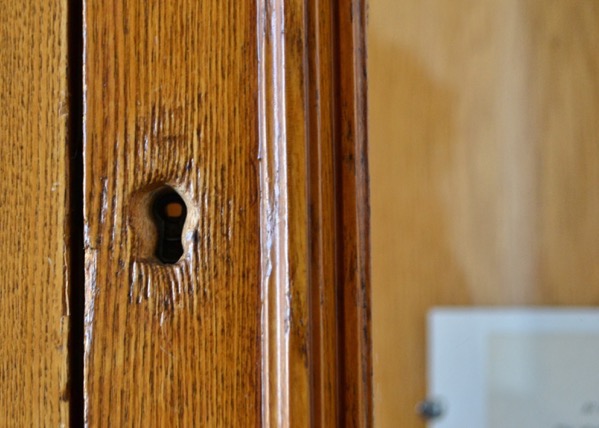
(130 year old key hole in a wooden cabinet in Lick Observatory.)

(First view of the river at the southern start of the trail.)
The Guadalupe River runs through San Jose beginning at Lake Almaden in south San Jose where streams combine, winding through San Jose’s heart, collecting more tributaries, and flowing into the San Francisco Bay at the northern tip of San Jose. There is no continuous trail along the entirety of the river, yet. There is, however, the Guadalupe River Trail which begins very close to the Tamien Light Rail and CalTrain stations and continues uninterrupted all the way out to the San Francisco Bay. That is a smooth 11 mile trail of adventure full of nature, urban life, art, and contemplation. In fact, it is a bit like a self-guided museum tour with informational plaques and lots to appreciate. I was inspired to make this ride after reading an article on baynature.org that I recommend and that inspired me to look for several historical points along the trail. But of course, I found so much more by going in person.
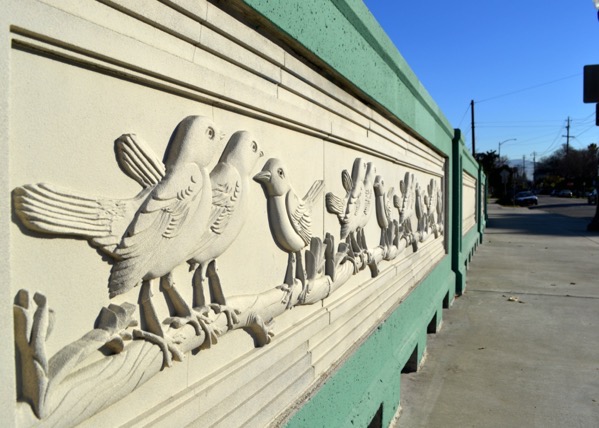
(Over this bridge’s ornamental guard rail is the Guadalupe River at the start of the trail.)
I took my bike on Light Rail to the Tamien station. From there, I went north a bit to the start of the trail. I thought it might take a couple of hours to travel the 11 miles as I would be stopping here and there instead of just commuting through it. I found that I stopped a lot more than I expected and happily took four hours to enjoy the trail. I likely would have taken longer had I the opportunity and will surely visit this trail and various parts of it again.

(The trail begins.)
Immediately upon entering the trail I found the first informative plaque. I loved these, reading most of them that I found along the way. I learned so much like why the area is called Tamien, that Goosetown is far more historically significant than just a bar’s name, that San Jose has built underground tunnels in the city to divert heavy rain flows from flooding while preserving some of the river’s ecosystem.

(View of the start of Downtown from the trail.)
Why is it so fun to learn about the land around you? I imagine it must be that sense of connection to the land, to the people, and to the people of history. It is fascinating to imagine the Muwekma tribe of Ohlone Native Americans living along the Guadalupe River in what is now San Jose. To imagine life for hundreds of years in a different culture than we have today. To see in one’s mind the establishment of San Jose way back in 1777, well before it was part of the US and just one year after the US was formed. To imagine transformations of our land under Native care, Spain’s rule, Mexico’s rule after gaining independence from Spain, and then as part of the United States of America. Later, the influx of diversity including the Italian immigrants of Goosetown building foundations for a rich history in the city, the development of China Town where now stands the Fairmont Hotel, Japan Town which continues to thrive, and so much more. As California became a state, San Jose served briefly as the first Capitol of the state. There is so much history here and so many intriguing humans have walked this land before us, so many intriguing humans share this land with us now.

(There are several statues along the trail of children discovering their environment. This young lady is exploring outside the Children’s Discovery Museum.)

(Mammoth statue peeking in. Not the last one you will see near the trail.)
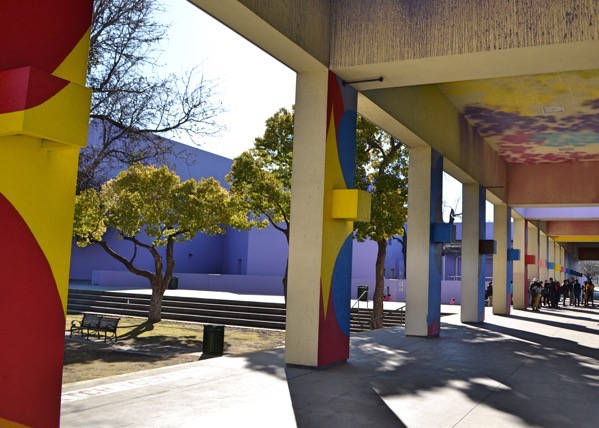
(Halls along the Children’s Discovery Museum and Light Rail station.)
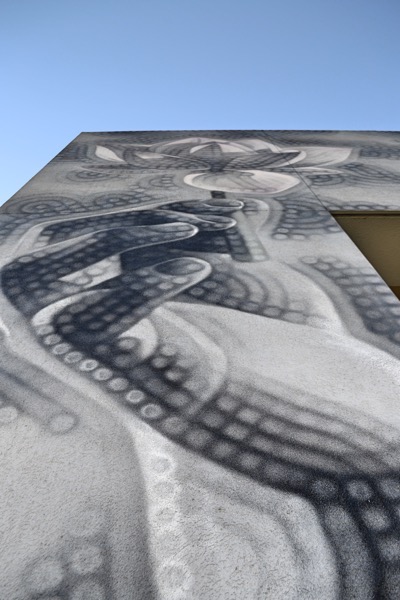
(A close up of Sophie’s hand.)
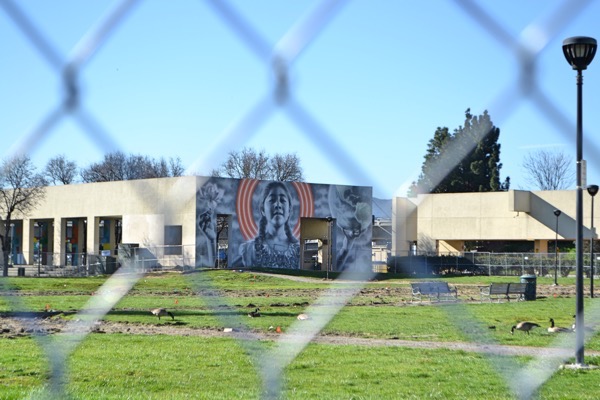 (Discovery Meadow is being refurbished. In the distance you can see the mural: “Sophie holding the world together.”)
(Discovery Meadow is being refurbished. In the distance you can see the mural: “Sophie holding the world together.”)

Most of the river in downtown had paved trail on both sides of the river. Further North, there was usually trail on both sides though at times one side would be gravel.

I have seen this building pictured above along highway 87 for years and never thought, as I drove along, that the river was so close at hand.

(A stop in Little Italy for a delicious cup of coffee.)
A couple of revelations came to me as I made the 11 mile bicycle journey, following the river to the bay. One appreciation is that I enjoy the smell of nature and while traveling the river, one can smell a change. At the south of downtown it has the thick vegetative smell of damp mud and plants. As you go north, it changes so that north of downtown it has that sweet smell of tule reeds in the marshes of the river. Both smells are excellent and different. A second revelation is that my mental map came together more in one afternoon on a bike than it had after many years of driving. So many times I heard myself thinking “that is right there?” Suddenly numerous places I have driven to or through became interconnected in a way they had never been before. A third revelatory thought that I had often along the rive was “What? The river was right here when I was driving over there all this time?!” Of course the Guadalupe River flows along Hwy 87, it is after all the Guadalupe Parkway. But I never realized the number of times I was driving right along the river, or over it, or that the, now obvious to me, path of trees indicate the banks of the river. Any one of those revelations alone would have made the ride worth it.

(This is one of my favorites of the children statues along the trail. These kids are looking over the rail at the river.)
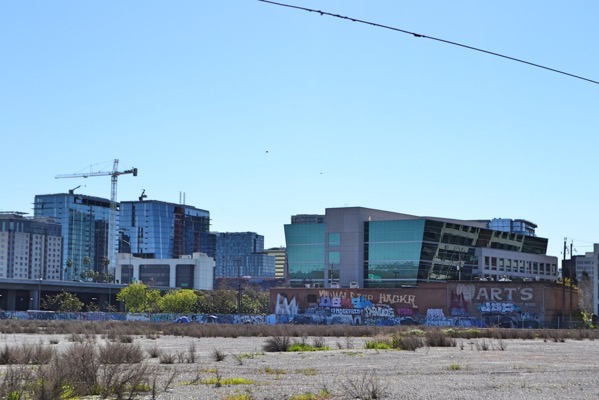
(Beyond the empty lot, amongst the development, notice a piece of history on the old brick wall… “Hart’s.”)
Do you remember Palm Pilots? Before there were smart phones? That shiny building on the right of the photo above was theirs back in the day. Do you see the brick wall in front of it with the painted old advertisement for Hart’s Department Store? That is a piece of history.
In 1933, two white men were lynched in San Jose at St. James Park across from the old court house. The two men had kidnapped the 21 year-old heir of Hart’s Department Store in an attempt to take a $40,000 ransom. The Hart family was a respected and appreciated part of the community and history of San Jose. When the two men accused of kidnapping were caught, they admitted to murdering the young man, Brooke Hart. A mob of San Jose citizens took the captured men and hung them from a tree right in St. James Park where President McKinley had spoken years before in 1901. That was the last lynching in San Jose, and some say in the state. That tree is gone as the city council of the time removed it under police guard to keep people from taking a souvenir. It is an eerie part of history to imagine. And there on that brick wall along a railroad track, between development and an empty lot, is a piece of that history still visible above the graffiti.
Something a bit more uplifting is all of the art that San Jose has on the streets. It has increased dramatically in the last several years and I love it. Several examples are seen along the trail.
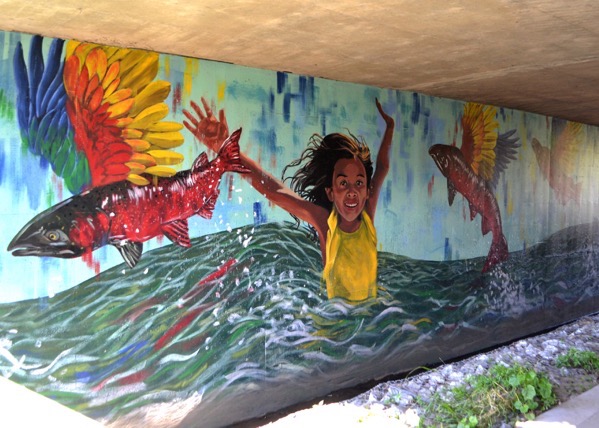
(Mural along a trail underpass.)
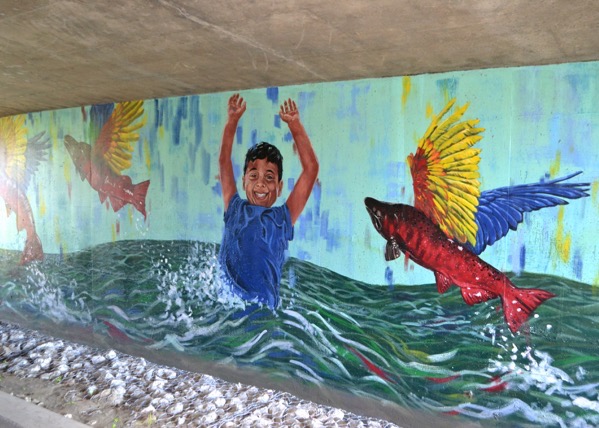
(The rest of this mural.)
I smile just looking at the kids on this mural. The joy of kids playing in water.. it makes me think of my own children playing.

(Lupe the Mammoth.)

In 2005, a nature lover spotted bones exposed on the banks of the Guadalupe river. It turned out to be a child Columbian Mammoth that has been named Lupe the Mammoth. Lupe roamed San Jose 12,500 years ago. Along the river where he was found, there now stands a life sized statue of him. This was one of the trail’s features that I was on the lookout for and very excited to find. I kept staring at Lupe and wondering who would be more frightened if we happened upon each other unexpectedly. He is a child, right? A child who stands twice as tall as I do. A child with giant tusks. Not sure who would be more startled but I’m fairly sure I would be the first to back out of that encounter.
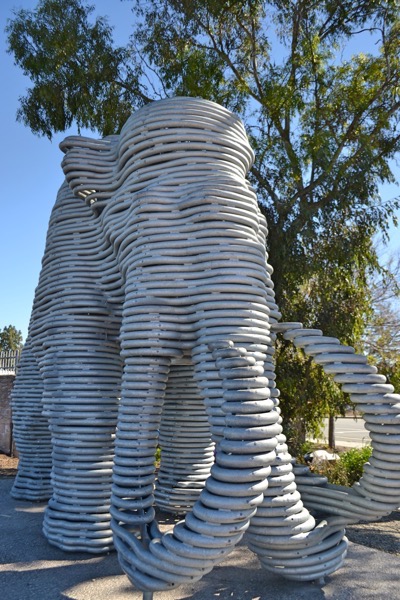

(The river north of the San Jose International Airport.)
It’s not just the natural smell of the river that changes as you head north. North of the San Jose airport the river changes personality as well. The area appearing natural around it is wider there, the smell is that sweet smell of tule reeds, and the feeling of the river is more relaxed.
Traveling north, leaving downtown and the airport, the river path ventures into Santa Clara for a while. There, you see the 49ers stadium, the mansion of James Lick (so much implied history just mentioning his name), and eventually meanders back into San Jose and into the Alviso area at its northern point.
That is when you get to say good bye to the river as it’s water, having traveled from the water shed of the Santa Cruz mountains, and along the Guadalupe River through San Jose, flows into the San Francisco Bay at the northern tip of our city in the Alviso Marina County Park.
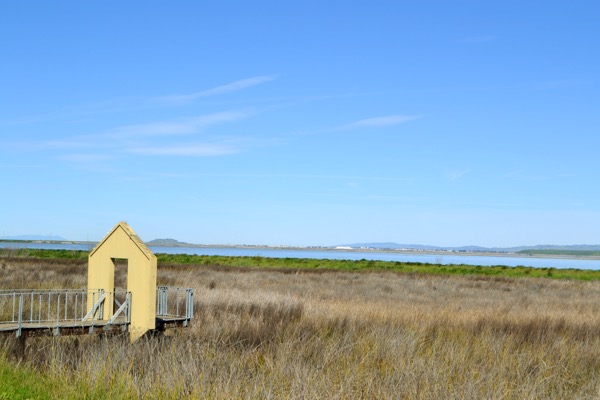
(Views of the marsh land and southern San Francisco Bay from Alviso Marina County Park.)
Notice the small white stripe on the land, near the middle of the photo above, on the land just the other side of the water? That is a GIANT mountain of salt! Salt is harvested through evaporation in southern parts of the San Francisco Bay. It is harvested and piled in to a mountain of salt which grows and shrinks through the cycle of harvest and packaging. Having once lived near to it, I always look for it when I see the bay and can imagine the billions of crystals waiting to end up in our salt shakers.
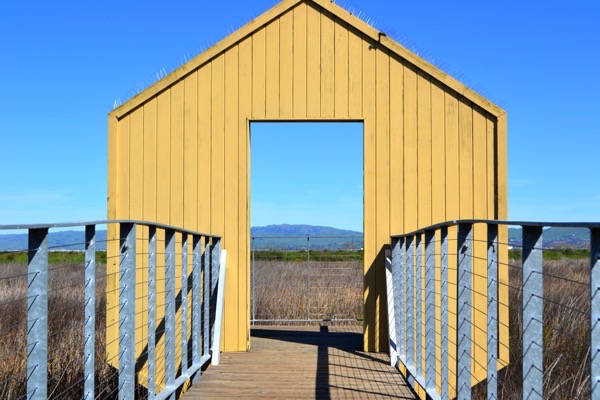
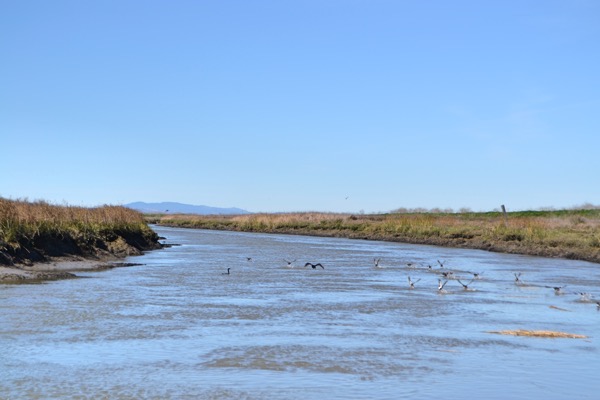
(The end of the river.)
And then it was time to say good-bye. Good-bye Guadalupe River! Out through the Alviso slough you go, into the San Francisco Bay.
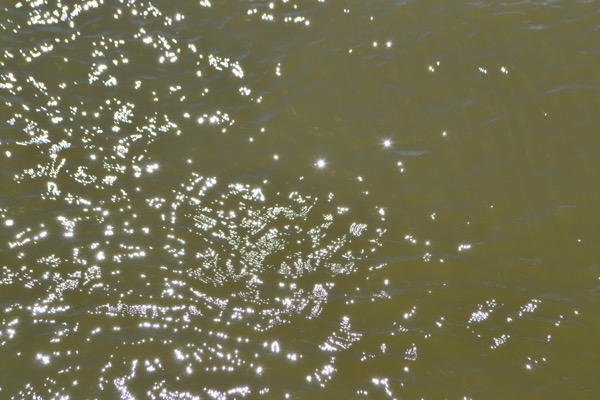
(I think it’s winking bye to us.)
A day well spent enjoying nature, art, and learning. A beautiful day. A new stripe of knowledge has opened up in my mind’s eye when I see the city map in my head. A stripe that is the Guadalupe River Trail.
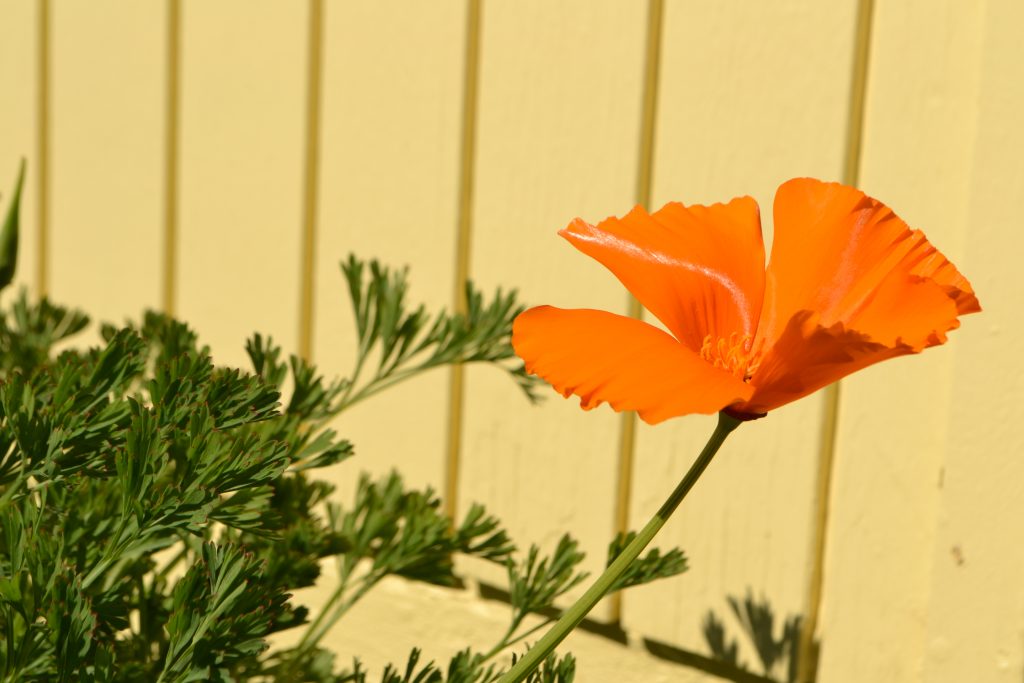

First California Poppy found of the season. The official California State Flower, Eschscholzia californica.
